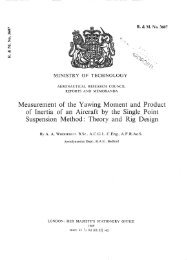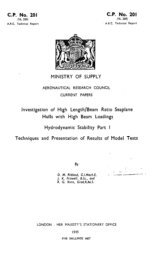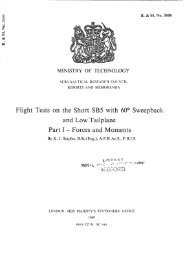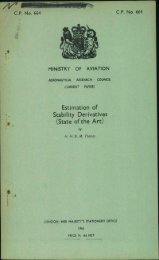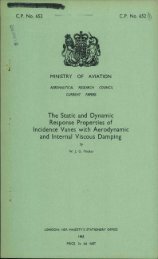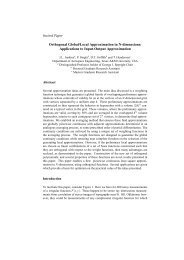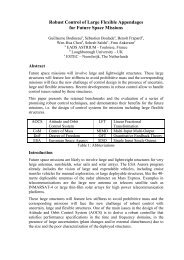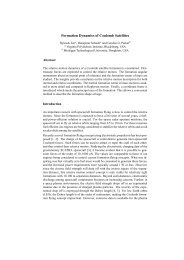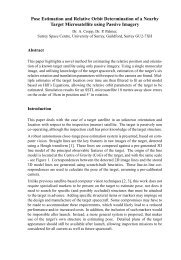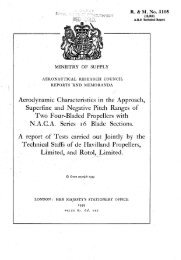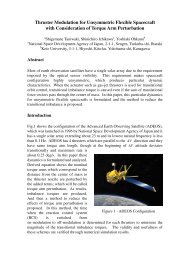The Aerodynamic Characteristics of Flaps
The Aerodynamic Characteristics of Flaps
The Aerodynamic Characteristics of Flaps
Create successful ePaper yourself
Turn your PDF publications into a flip-book with our unique Google optimized e-Paper software.
<strong>The</strong> analysis did not indicate any marked systematic interference effects on lift coefficient<br />
increments ; in general, the effect was negligible, although in a few cases it was appreciable.<br />
8. <strong>Flaps</strong> Combined with Wing Leading-edge Slats.--Some <strong>of</strong> the high-lift flaps discussed above<br />
have been tested in combination with wing leading-edge slats, 68' 7<br />
<strong>The</strong> data are scanty but an analysis has been made by Young in Ref. 3 and the main conclusions<br />
suggest the following relations for full-span slats <strong>of</strong> chord lengths within the range<br />
0.15c to 0.3c set at about 40 deg to the wing chord line :-<br />
slat chord<br />
(i) A Cz max -----3"3 wing chord' approx.,<br />
slat chord<br />
(ii) A C,~ ,<br />
where AC,~(~.~ is.the change in pitching moment coefficient at the stall produced by the slat,<br />
and A %,.~ is the change in stalling angle produced by the slat. <strong>The</strong>se increments are additive to<br />
those produced by the flap.<br />
9. Effect <strong>of</strong> <strong>Flaps</strong> on I~duced Drag.--In considering the effect <strong>of</strong> flaps on drag we have so<br />
far only considered the effect on pr<strong>of</strong>ile drag, but flaps may have an important effect on induced<br />
drag. This latter effect has been considered theoretically by Young in Ref. 96, where the induced<br />
drags <strong>of</strong> elliptic wings with flaps <strong>of</strong> various span and various cut-outs have be~en determined.<br />
It Js shown that the induced drag can be put in the form<br />
CL2 K(ACL) 2 . . . . . . . . (25)<br />
C~ -- ~A ' + ~A " " . . . .<br />
where C~ is the total lift coefficient <strong>of</strong> wing plus flap, A CL is the lift coefficient increment due<br />
to the flap, and K is a function <strong>of</strong> the flap span and cut-out and <strong>of</strong> the ratio <strong>of</strong> the aspect ratio<br />
(A) to the two-dimensional lift-curve slope <strong>of</strong> wing (a0). <strong>The</strong> function K is reproduced in Figs.<br />
18, 19, 20; these figures correspond to A/ao = §, 1.0 and 2.0 (i.e., A = 4, 6, 12 approximately),<br />
respectively.<br />
It will be seen that the above formula for Cv~ takes the form <strong>of</strong> the usual elliptic loading term<br />
(CL ~]~A) plus a term which arises from the departure <strong>of</strong> the loading <strong>of</strong> the flapped wing from the<br />
elliptic ; it is clear that the latter term can be very important. For a given net flap span this<br />
term appears to be least for a cut-out <strong>of</strong> about 0.1 wing span. It is suggested that where<br />
the plan form <strong>of</strong> the unflapped wing departs appreciably from the elliptic the first term in the<br />
above expression for Cv~ should be replaced by (CL2/~A) (1 + z) where ~ is the appropriate<br />
correction factor for non-elliptic plan form given by Glauert in Ref. 12.<br />
Similar Calculations made for flaps that extend the chord 96 showed that, when the induced<br />
drag was expressed in the form <strong>of</strong> equation (25) above, the chord extension made a negligible<br />
difference to the factor K.<br />
10. Nose <strong>Flaps</strong>.--Thin high-speed wing sections with fairly small nose radii <strong>of</strong> curvature<br />
tend to have low maximum lift coefficients, because <strong>of</strong> the tendency to flow breakaway induced<br />
by the sharp wing nose at incidence. It has been suggested that the nose flap might overcome<br />
this difficulty. Two forms <strong>of</strong> nose flap have been developed, one suggested and tested in Germany<br />
by Kruge r97' 98,100, the other has been suggested in this country.*<br />
* t~.ecent evidence 99 indicates that the Germans were interested in the second form_ as well as the first,<br />
19



